California's mallard population is in decline
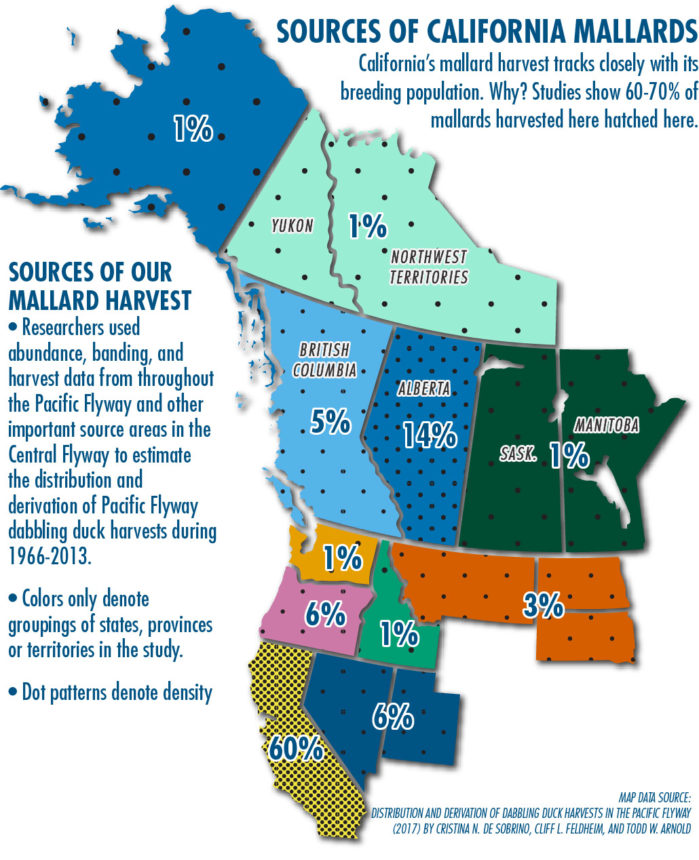
Click here to see at full size. Source: Distribution and derivation of dabbling duck harvests in the Pacific Flyway
California is unusual compared with the rest of the nation in that the majority of mallards that are harvested here hatched here, rather than coming from the "Duck Factory" Prairie Pothole Region of the central United States and Canada.
In addition, our mallards don't tend to leave in the winter: According to research, of California mallards that are harvested, 96% are harvested here. Oregon gets 3%.
Unfortunately, our breeding population of mallards used to be much stronger, but after plunging during the recent drought, it has failed to rebound.

What's holding mallards back?
Several major factors, and all are about habitat:
- The Sacramento Valley has experienced a substantial loss of breeding habitat, fueled in part by significant changes in agricultural practices.
- Water is being deliberately withheld from the Lower Klamath National Wildlife Refuge, and drought is making the situation even worse. The refuge is in a state of crisis. Lower Klamath – when it has water – is not only a significant breeding area, but also a molting area, which is critical for California's mallards.
- Water diversion measurement requirements and mosquito abatement limit the availability of summer brood water in many parts of the state.
- New groundwater restrictions are likely to exacerbate problems with summer brood water going forward.
WHAT is CWA DOING TO ADDRESS THE PROBLEM?
We are working to address this problem on multiple fronts:
- Our regional biologists develop breeding habitat on both public and private lands. They have seeded more than 10,000 acres with perennial grass seed to create ideal nesting habitat near wetlands that are specifically managed for brood-rearing. Contact them if you'd like help with a wetland that you manage.
- Our advocacy team fights for funding to improve breeding habitat, including a very important bill to fund the Nesting Bird Habitat Incentive Program.
- Our waterfowl program staff:
—Created this guide to improving breeding habitat.
—Bands ducks for research. - Our Egg Salvage Program works with wildlife-friendly farmers to salvage duck nests from their fields prior to normal farming operations that might destroy nests.
- Our Delayed Wheat Harvest Incentive Program provides incentives for farmers to delay wheat harvest long enough to let ducklings hatch naturally and leave the field with their mothers.
- We are fighting to restore a reliable water supply to the Lower Klamath National Wildlife Refuge, which provides critical breeding and molting habitat for California mallards.
California Waterfowl convened a mallard summit on Aug. 3, 2019, bringing together representatives of a variety of governmental and non-governmental agencies to discuss the issues affecting mallard populations. (Click here for a copy of Powerpoint presentations - warning: 253MB.)
Would reducing mallard limit to five solve the problem?
No, for two reasons:
One: Research tells us that reducing the mallard limit to five per day would not reduce overall harvest. This is because very few California hunters kill five mallards in a day, much less seven. The average at the state's Type A and B wildlife areas and national wildlife refuges in 2020-21 was 0.15 mallards per hunter per day (source: DFW 2020-21 harvest data). In the 2019-20 season, California's 64,176 duck validation holders (source: state license data) killed an estimated 147,680 mallards (source: U.S. Fish & Wildlife Service harvest estimates - see p. 22), which comes out to 2.3 mallards per hunter per season.
To reduce harvest in a statistically significant way, we would need to go to the most restrictive alternative under the U.S. Fish & Wildlife Service's Adaptive Harvest Management model: a 60-day season with a limit of three mallards per hunter per day, with no more than one being a hen.
Two: Even if we do reduce harvest, it likely won't help the population. A growing body of research - including this 2019 study and this 2012 study - tells us that harvest at current levels does not have a noticeable impact on waterfowl populations; their rise and fall each year hinges almost entirely on habitat, namely habitat for nesting and brood-rearing, and the precipitation that determines the health of that habitat in any given year. This is not to suggest that harvest could never affect breeding populations; it would just have to be at much higher levels than current limits allow.
California Waterfowl is a science-based organization that remains open to learning from evolving science, which our staff of professional biologists monitors closely.
Want to support our efforts?
All donations to CWA support our efforts, but we have two areas where donations are earmarked specifically for our efforts to boost mallard populations:
DONATE TO SAVE LOWER KLAMATHDONATE TO DELAY WHEAT HARVEST
THE LATEST NEWS ABOUT CALIFORNIA MALLARDS
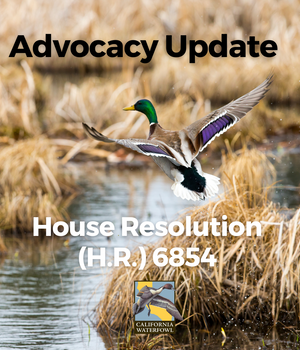
CWA Advocacy update - H.R. 6854 Introduced
California Waterfowl has joined with our partners at Delta Waterfowl and Ducks Unlimited to support federal legislation that would provide critical breeding habitat for waterfowl both in California and the Prairie Pothole Region of the Upper Midwest.
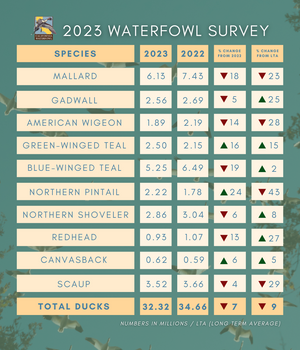
2023 Waterfowl Survey
According to the 2023 Waterfowl Population Status report recently released by the U.S. Fish and Wildlife Service (USFWS), total breeding populations were estimated at 32.3 million breeding ducks in the traditional survey area — a 7% decrease from last year’s estimate of 34.7 million and 9% below the long-term average of 35.5 million since 1955.
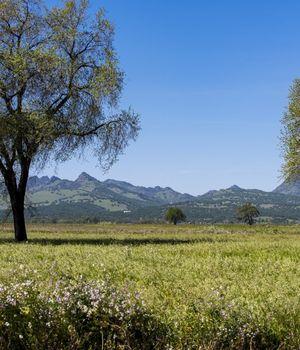
RCPP Final Application Reminder
RCPP Final Application Reminder The application deadline for practices through the Regional Conservation Partnership Program (RCPP) is fast approaching. To be eligible for participating in any practices this spring or fall, producers must sign up by May 1, 2023.
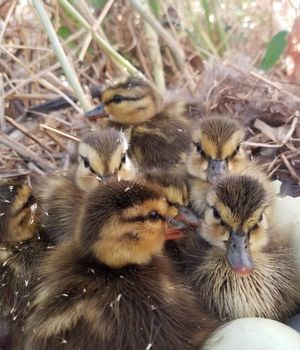
Open Enrollment for Nesting Habitat on Private Lands
California Waterfowl Association is currently soliciting landowner applications for the California Department of Fish and Wildlife’s Nesting Bird Habitat Incentive Program. The program is designed to enhance waterfowl nesting habitat this spring and summer.
RESEARCH AND DATA
2021 Adaptive Harvest Management (PDF) (establishes 2021-22 regulatory framework)
Migratory bird hunting activity and harvest during the 2018–19 and 2019–20 hunting seasons (August 2020)
Assessing changes in genomic divergence following a century of human-mediated secondary contact among wild and captive-bred ducks (PDF) (December 2019)
Identifying hybrids & the genomics of hybridization: Mallards & American black ducks of Eastern North America (January 2019)
Experimental harvest regulations reveal that water availability during spring, not harvest, affects change in a waterfowl population (August 2019) by Sedinger et. al.
CRITICAL HUB: LKNWR (Infographic PDF) (California Waterfowl, Fall 2019)
2020 Adaptive Harvest Management (PDF) (establishes 2020-21 regulatory framework)
2019 Adaptive Harvest Management (PDF) (establishes 2019-20 regulatory framework)
2019 California Waterfowl Breeding Population Survey Report
Waterfowl Population Status, 2019 (continental breeding population survey)
CWA Mallard Meeting powerpoints (Warning: 253MB!) (Aug. 3, 2019)
Sources of California mallards - Mallard Meeting poster at 8.5x11 - PDF (Aug. 3, 2019)
Migratory bird hunting activity and harvest during the 2017-18 and 2018-19 hunting seasons, August 2019 (continental harvest survey)
California mallards: a review (2018) by Cliff L. Feldheim, Joshua T. Ackerman, Shaun L. Oldenburger, John M. Eadie, Joseph P. Fleskes, And Gregory S. Yarris
Populations and harvest (infographic PDF, 3.6 MB) (California Waterfowl, Winter 2017)
Distribution and derivation of dabbling duck harvests in the Pacific Flyway (2017) by Cristina N. de Sobrino, Cliff L. Feldheim, and Todd W. Arnold
Harvest and dynamics of duck populations (2012) by Sedinger and Herzog
Flightless and post-molt survival and movements of female mallards molting in Klamath Basin (2010) by Fleskes et al
RECENT LEGISLATION CWA HAS FOUGHT FOR
2021
Duck and pheasant breeding habitat fee Added: AB 614 (Cecilia Aguiar-Curry, D-Winters): This CWA-sponsored bill would add $5 to the state upland bird and waterfowl validations to give a much-needed boost to California’s waterfowl and pheasant breeding populations, which are suffering habitat declines. The revenue would support the Nesting Bird Habitat Incentive Program, which was created by AB 2697 (James Gallagher, R-Yuba City ) in 2018, but not funded. The incentive program can pay farmers and other landowners, including private duck clubs, to fallow, grow cover crops like vetch or enhance existing nesting habitat. If a landowner wanted to also open the field to public pheasant hunting, for example, he or she could be paid to provide that public benefit too. Monies could also be used on state wildlife areas and national wildlife refuges to improve breeding habitat on those lands and thus increase public land hunter opportunity. In a 2019 survey, 74% of CWA members and supporters said they would support the additional fee to boost breeding habitat.2020
Duck and pheasant breeding habitat fee - did not pass
AB 2106 (Cecilia Aguiar-Curry, D-Winters): This CWA-sponsored bill would have added $5 to the state upland bird and waterfowl validations to give a much-needed boost to California's waterfowl and pheasant breeding populations, which are suffering habitat declines. The revenue would support the Nesting Bird Habitat Incentive Program, which was created by AB 2697 (James Gallagher, R-Yuba City ) in 2018, but not funded. The incentive program can pay farmers and other landowners, including private duck clubs, to fallow, grow cover crops like vetch or enhance existing nesting habitat. If a landowner wanted to also open the field to public pheasant hunting, for example, he or she could be paid to provide that public benefit too. Monies could also be used on state wildlife areas and national wildlife refuges to improve breeding habitat on those lands and thus increase public land hunter opportunity. In a survey last year, 74% of CWA members and supporters said they would support the additional fee to boost breeding habitat. Click here to read our letter of support (PDF).
2019
Wildlife-friendly agriculture - did not pass
SB 253 (Bill Dodd, D-Napa): Would establish an incentive-based conservation program at the California Department of Food and Agriculture and require the program to optimize wildlife habitat benefits while supporting the economic viability of California agriculture by providing incentives and technical assistance to farmers and ranchers. Click here to read our coalition letter of support (PDF).
Funding to purchase wildlands - INCLUDED IN STATE BUDGET
SB 474 (Henry Stern, D-Canoga Park): Would extend the sunset date on the Habitat Conservation Fund, which annually transfers $30 million to various natural resource entities, including the Wildlife Conservation Board, to purchase wildlands for the public, establish conservation easements on private land and enhance the habitat values of existing public lands. The Habitat Conservation Fund has put nearly $420 million into more than 800 projects statewide, including land purchases, easements and improvements. CWA has done work with these funds in 19 counties from Siskiyou to Imperial. Huntable public lands that have benefited from the fund include the Ash Creek, Gray Lodge, Yolo Bypass, Grizzly Island, North Grasslands, Mendota and San Jacinto wildlife areas. Click here to read a conservation coalition letter of support (PDF). Update: This legislation was incorporated into the state budget, so this funding has been extended for 10 years.
2018
Nesting habitat incentive - passed and signed by governor
AB 2697 (Gallagher, R-Yuba City): This CWA-sponsored bill created a waterfowl and upland game bird Nesting Bird Habitat Incentive Program for farmers who wish to fallow a portion of their land. View our letter (PDF) here. CWA is is currently working with the Legislature to secure funding for the program.
Proposition 68 - passed by voters
Prop. 68 included $10 million for the Presley Program, which provides incentive funding to improve wetland management on private wetlands and prioritizes properties with breeding habitat. California Waterfowl played a significant role in getting the Presley funding into the initiative. Voters passed the initiative 57% to 43%.
Federal Farm Bill - passed and signed into law
The 2018 Farm Bill provides significant funding for a number of conservation programs, including:
- The Environmental Quality Incentives Program (EQIP), which provides farmers financial assistance to implement a variety of conservation practices. This program could help support the Nesting Bird Habitat Incentive Program, which was created in 2018 through a CWA-sponsored bill (AB 2697 by James Gallagher, R-Yuba City) to create and enhance nesting habitat for mallards and pheasants on fallowed lands.
- The Regional Conservation Partnership Program (RCPP), which fosters partnerships with farmers, state agencies and nonprofit groups to implement conservation initiatives. RCPP could also help support California’s Nesting Bird Habitat Incentive Program.
- The Agricultural Conservation Easement Program (ACEP) supports the former Wetlands Reserve Program, which is used by many duck clubs that choose to protect their wetlands in perpetuity.
View our letter (PDF) here.


